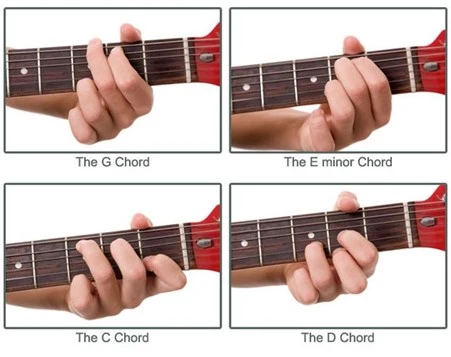Guitar Chords for Beginner: Your Gateway to Playing Music

If you’ve ever dreamed of strumming your favorite songs on a guitar, you’re in the right place. Learning beginner guitar chords is your first step to becoming a guitarist. In this article, we’ll guide you through the fundamentals, teach you essential chords, and offer tips to get you started on your musical journey.
Table of Contents
- Understanding the Basics of Guitar Chords
- Major Chords
- Minor Chords
- Dominant 7th Chords
- How to Read Chord Diagrams
- Essential Beginner Guitar Chords
- C Major
- G Major
- D Major
- A Major
- E Major
- Tips for Proper Hand Position
- Strumming Techniques
- Practice Makes Perfect
- Troubleshooting Common Challenges
- Playing Your First Song
- Additional Resources
- Conclusion
Understanding the Basics of Guitar Chords
Guitar chords are combinations of two or more notes played simultaneously, creating harmonious sounds. These chords are the building blocks of songs, allowing you to play melodies, rhythm, and lead guitar parts. To get started, let’s explore the common chord types:
Read More: All Subjects Teachers Guide, Textbooks, Lesson Plans and Starters
Major Chords
Major chords have a happy and stable sound. They consist of three notes: the root, major third, and perfect fifth. Examples include C Major, G Major, and D Major.
Minor Chords
Minor chords have a sadder, more melancholic tone. They also comprise three notes: the root, minor third, and perfect fifth. Common minor chords include A Minor and E Minor.
Dominant 7th Chords
Dominant 7th chords have a bluesy, soulful feel. They contain four notes: the root, major third, perfect fifth, and minor seventh. A classic example is the G7 chord.
READ ALSO: How parents can demand quality education for their wards from schools and teachers
How to Read Chord Diagrams
Before we dive into specific chords, let’s learn how to read chord diagrams. These visual representations show you where to place your fingers on the fretboard. Each dot on the diagram corresponds to a finger position on the guitar.
Essential Beginner Guitar Chords
Mastering beginner guitar chords is like learning the alphabet before you can read or write. These foundational chords are the core of your guitar journey. Here, we’ll take a closer look at the five essential beginner chords: C Major, G Major, D Major, A Major, and E Major.
C Major
C Major is often the first chord beginners tackle because it’s relatively straightforward.
It’s an open chord, which means you don’t need to press down on any frets. To play C Major, place your ring finger on the 3rd fret of the 5th string, middle finger on the 2nd fret of the 4th string, and your index finger on the 1st fret of the 2nd string. Strum all the strings except the 6th one.
The result is a bright and cheerful sound, making C Major an excellent choice for your early chord repertoire.
G Major
G Major is another open chord but is a bit more challenging. To play it, place your index finger on the 2nd fret of the 5th string, your middle finger on the 3rd fret of the 6th string, and your ring finger on the 3rd fret of the 2nd string. Strum all the strings for a rich, resonant sound. This chord is a fundamental building block for countless songs and a great chord to advance to after mastering C Major.
D Major
D Major is your next step in learning. This chord involves fretting some strings. Place your index finger on the 2nd fret of the 3rd string, your middle finger on the 2nd fret of the 1st string, and your ring finger on the 3rd fret of the 2nd string.
Strum from the 4th string down, creating a beautiful and uplifting tone. Transitioning to and from D Major is an excellent exercise to develop chord-changing skills.
A Major
A Major is an open chord with a warm and full sound. To play it, place your index finger on the 2nd fret of the 4th string, your middle finger on the 2nd fret of the 3rd string, and your ring finger on the 2nd fret of the 2nd string.
Strum all the strings for a melodious sound. A Major is commonly used in various songs and is a must-know for beginners.
E Major
E Major is a versatile and essential chord with a bright and lively sound. To play it, place your index finger on the 1st fret of the 3rd string, your middle finger on the 2nd fret of the 5th string, and your ring finger on the 2nd fret of the 4th string. Strum all the strings except the 6th for a crisp and vibrant tone. E Major is a favorite among songwriters and adds depth to your chord repertoire.
These essential beginner guitar chords are the stepping stones to playing your favorite songs. By practicing and mastering them, you’ll be well on your way to becoming a proficient guitarist.
Tips for Proper Hand Position
As a beginner, maintaining the right hand position is crucial. Ensure your fingers are pressing the strings firmly and your wrist isn’t bent awkwardly. Practice your hand positioning to avoid unnecessary strain and improve your playing.
Strumming Techniques
Mastering various strumming patterns adds depth to your playing. Experiment with downstrokes, upstrokes, and rhythmic patterns to give your chords character and groove.
Practice Makes Perfect
Learning guitar chords takes time and practice. Dedicate a few minutes daily to chord transitions and strumming. Consistency is key to becoming a proficient guitarist.
Troubleshooting Common Challenges
Every guitarist faces challenges, such as buzzing strings or muted notes. Don’t be discouraged. These issues are part of the learning process. With time and practice, you’ll overcome them.
Playing Your First Song
Once you’ve gained confidence in your chord transitions and strumming, it’s time to play your first song. Choose a simple song with the chords you’ve learned to enjoy the thrill of making music.
Additional Resources
For more in-depth learning, consider online tutorials, chord books, and guitar apps. These resources can provide valuable insights and support on your guitar journey.
Conclusion
Learning beginner guitar chords is an exciting first step toward your musical aspirations. With practice and determination, you’ll soon be strumming your favorite tunes and creating your music. So grab your guitar, follow the chord diagrams, and make beautiful music!
Send Stories | Social Media | Disclaimer
Send Stories and Articles for publication to [email protected]
We Are Active On Social Media
WhatsApp Channel: JOIN HERE
2024 BECE and WASSCE Channel - JOIN HERE
Facebook: JOIN HERE
Telegram: JOIN HERE
Twitter: FOLLOW US HERE
Instagram: FOLLOW US HERE
Disclaimer:
The information contained in this post on Ghana Education News is for general information purposes only. While we endeavour to keep the information up to date and correct, we make no representations or warranties of any kind, express or implied, about the completeness, accuracy, reliability, suitability or availability with respect to the website or the information, products, services, or related graphics contained on the post for any purpose.




 Only 44% of primary schools, 63.9% of JHSs had access to electricity by 2020 — EduWatch
Only 44% of primary schools, 63.9% of JHSs had access to electricity by 2020 — EduWatch  GES Announces Recruitment for 2022 College of Education Batch
GES Announces Recruitment for 2022 College of Education Batch  GES extends SHS/SHTS students’ voter ID Card registration period
GES extends SHS/SHTS students’ voter ID Card registration period  How AI Can Transform Lesson Notes Writing for Teachers
How AI Can Transform Lesson Notes Writing for Teachers